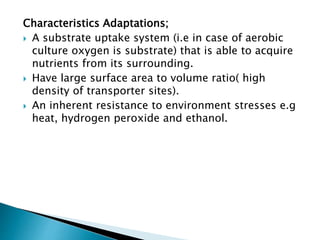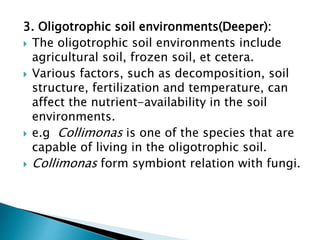OLIGOTROPHS ; microbial life at low nutrients.
- 2. Presenter : Tahir Ali Presented To: Dr Sagheer Ahmed Roll # College/uni: 852/023814 Govt. post graduate college of science wahdat road lahore.
- 3. Oligotrophs: From Greeks oligos mean ‘few’ and trophos means ‘food’. Definition: An oligotroph is an organism that can live in an environment that offers very low levels of nutrients. They may be contrasted with copiotrophs, which prefer nutritionally rich environments. Oligotrophs are characterized by: slow growth, low rates of metabolism, and generally low population density.
- 4. e.g: 1.Oligotrophic bacterium sphingomonas sp. Single copy of rRna operon . Relatively small in size and genome. 2. Cyclolasticus oligotrophicus: Same as sphingomonas sp. 3. Arthrobacter sp 4. Pseudomonas sp 5. Caulobacter sp. 6. Certain lower fungi.
- 5. Occurrence; Deep oceans sediments Caves Glacial and polar ice Aquifers Leached soil These environments are known as oligotrophic environments. The term “oligotrophic” is commonly used to describe terrestrial and aquatic environments with very low concentrations of nitrates, iron, phosphates, and carbon sources.
- 6. Characteristics Adaptations; A substrate uptake system (i.e in case of aerobic culture oxygen is substrate) that is able to acquire nutrients from its surrounding. Have large surface area to volume ratio( high density of transporter sites). An inherent resistance to environment stresses e.g heat, hydrogen peroxide and ethanol.
- 7. Complex regulatory mechanism is activated in response to starvation (limited nutrients level): Expression of starvation genes results in reduction in size and the formation of ultra micro bacteria, usually by a process of reductive division.
- 8. Protective starvation proteins are synthesized . Amino acids uptake increases. At this stage cells may enter a dormant ,anabiotic state that permits them to survive for a long period of time without any division Reductive Division; It is a form of cell adaptations to adverse environmental conditions. Reductive division allows the cell to gain advantage under conditions of starvation due to increased surface to volume ratio, producing more spherical cells .
- 9. 1. Antarctica Antarctic environments offer very little to sustain life as most organisms are not well adapted to live under nutrient-limiting conditions and cold temperatures (lower than 5 °C). As such, these environments display a large abundance of psychrophiles that are well adapted to living in an Antarctic biome. Most oligotrophs live in lakes where water helps support biochemical processes for growth and survival.
- 10. 2.Crooked Lake: is an ultra-oligotrophic glacial lake with a thin distribution of heterotrophic and autotrophic microorganisms. The microbial loop plays a big role in cycling nutrients and energy within this lake, despite particularly low bacterial abundance and productivity in these environments. Species discovered in this lake include: Ochromonas, Chlamydomonas, Scourfeldia, Cryptomonas and Akistrodesmus falcatus.
- 11. 3. Oligotrophic soil environments(Deeper): The oligotrophic soil environments include agricultural soil, frozen soil, et cetera. Various factors, such as decomposition, soil structure, fertilization and temperature, can affect the nutrient-availability in the soil environments. e.g Collimonas is one of the species that are capable of living in the oligotrophic soil. Collimonas form symbiont relation with fungi.
- 13. References: Environmental microbiology by Alan H. varnam. Environmental microbiology by Eugene L. Medsen. Slideshare.net Wikipedia.net












